Are Filter-Tipped Cigarettes Still Less Harmful than Non-Filter Cigarettes?—A Laser Spectrometric Particulate Matter Analysis from the Non-Smokers Point of View
Abstract
:1. Introduction
2. Experimental Section
2.1. Cigarette Products
2.2. Automatic Environmental Tobacco Smoke Emitter (AETSE)
2.3. The Smoking Protocol
2.4. Data Processing and Data Analysis
3. Results and Discussion
3.1. Results
3.2. Discussion
4. Conclusions
Acknowledgments
Author Contributions
Conflicts of Interest
References
- Mund, M.; Kloft, B.; Bundschuh, M.; Klingelhoefer, D.; Groneberg, D.A.; Gerber, A. Global research on smoking and pregnancy—A scientometric and gender analysis. Int. J. Environ. Res. Public Health 2014, 11, 5792–5806. [Google Scholar] [CrossRef] [PubMed]
- Mund, M.; Louwen, F.; Klingelhoefer, D.; Gerber, A. Smoking and pregnancy—A review on the first major environmental risk factor of the unborn. Int. J. Environ. Res. Public Health 2013, 10, 6485–6499. [Google Scholar] [CrossRef] [PubMed]
- Gerber, A.; Bigelow, A.; Schulze, M.; Groneberg, D.A. Brand cigarillos—A cheap and less harmful alternative to cigarettes? Particulate matter emissions suggest otherwise. Int. J. Environ. Res. Public Health 2015, 12, 428–438. [Google Scholar] [CrossRef] [PubMed]
- Singer, M.V.; Batra, A.; Mann, K. Alkohol und Tabak: Grundlagen und Folgeerkrankungen; Georg Thieme Verlag KG Stuttgart: New York, NY, USA, 2010; p. 51. [Google Scholar]
- Wong, L.S.; Martins-Green, M. Firsthand cigarette smoke alters fibroblast migration and survival: Implications for impaired healing. Wound Repair Regen. 2004, 12, 471–484. [Google Scholar] [CrossRef] [PubMed]
- Gerber, A.; Hofen-Hohloch, A.V.; Schulze, J.; Groneberg, D.A. Tobacco smoke particles and indoor air quality (ToPIQ-II)—A modified study protocol and first results. J. Occup. Med. Toxicol. 2015, 10, 5. [Google Scholar] [CrossRef] [PubMed]
- Neininger, S. Die Entstehung von Feinstaub und die Gefahren für Mensch und Umwelt; Grin Verlag GmbH: München, Gemany, 2010; p. 2. [Google Scholar]
- Harrison, R.M.; Yin, J. Particulate matter in the atmosphere: which particle properties are important for its effects on health? Sci. Total Environ. 2000, 249, 85–101. [Google Scholar] [CrossRef]
- Balmes, J.R.; Cisternas, M.; Quinlan, P.J.; Trupin, L.; Lurmann, F.W.; Katz, P.P.; Blanc, P.D. Annual average ambient particulate matter exposure estimates, measured home particulate matter, and hair nicotine are associated with respiratory outcomes in adults with asthma. Environ. Res. 2014, 129, 1–10. [Google Scholar] [CrossRef] [PubMed]
- Anderson, J.O.; Thundiyil, J.G.; Stolbach, A. Clearing the air: A review of the effects of particulate matter air pollution on human health. J. Med. Toxicol. 2012, 8, 166–175. [Google Scholar] [CrossRef] [PubMed]
- Li, M.-H.; Fan, L.-C.; Mao, B.; Yang, J.-W.; Choi, A.M.K.; Cao, W.-J.; Xu, J.-F. Short term exposure to Ambient fine particulate matter (PM2.5) increases hospitalizations and mortality of chronic obstructive pulmonary disease: A systematic review and meta-analysis. CHEST J. 2015. [Google Scholar] [CrossRef]
- Gawlik, F.M. Möglichkeiten der Raucherprävention bei Jugendlichen: Pilotstudie zu einem Raucherpräventionsprogramm der Universitätsklinik Freiburg und dessen Auswirkungen auf das Verhalten von Schülern; IGEL-Verlag GmbH: Hamburg, Germany, 2009; pp. 48–52. [Google Scholar]
- Ito, H.; Matsuo, K.; Tanaka, H.; Koestler, D.C.; Ombao, H.; Fulton, J.; Shibata, A.; Fujita, M.; Sugiyama, H.; Soda, M.; et al. Nonfilter and filter cigarette consumption and the incidence of lung cancer by histological type in Japan and the United States: Analysis of 30-year data from population-based cancer registries. Int. J. Cancer 2011, 128, 1918–1928. [Google Scholar] [CrossRef] [PubMed]
- Brownson, R.C.; Eriksen, M.P.; Davis, R.M.; Warner, K.E. Environmental tobacco smoke:Health effects and policies to reduce exposure. Annu. Rev. Public Health 1997, 18, 163–185. [Google Scholar] [CrossRef] [PubMed]
- Fu, J.Y.; Gao, J.; Zhang, Z.Y.; Zheng, J.W.; Zhong, L.P.; Luo, J.F.; Xiang, Y.B. Role of cigarette filter on the risk of oral cancer: A case-control study in a Chinese population. Oral Dis. 2013, 19, 80–84. [Google Scholar] [CrossRef] [PubMed]
- Macigo, F.G.; Mwaniki, D.L.; Guthua, S.W.; Njeru1, E.K. Influence of cigarette filters on the risk of developing oral leukoplakia in a Kenyan population. Oral Dis. 2001, 7, 101–105. [Google Scholar] [CrossRef] [PubMed]
- Böcker, W.; Aguzzi, A. Pathologie, 4th ed.; Urban & Fischer: München, Gemany, 2008; pp. 167–168. [Google Scholar]
- Cavallo, D.; Ursini, C.L.; Fresegna, A.M.; Maiello, R.; Ciervo, A.; Ferrante, R.; Buresti, G.; Iavicoli, S. Cyto-genotoxic effects of smoke from commercial filter and non-filter cigarettes on human bronchial and pulmonary cells. Mutat. Res. 2013, 750, 1–11. [Google Scholar] [CrossRef] [PubMed]
- Behera, S.N.; Xian, H.; Balasubramanian, R. Human health risk associated with exposure to toxic elements in mainstream and sidestream cigarette smoke. Sci. Total Environ. 2014, 472, 947–956. [Google Scholar] [CrossRef] [PubMed]
- Ramírez, N.; Özel, M.Z.; Lewis, A.C.; Marcé, R.M.; Borrull, F.; Hamilton, J.F. Exposure to nitrosamines in thirdhand tobacco smoke increases cancer risk in non-smokers. Environ. Int. 2014, 71, 139–147. [Google Scholar] [CrossRef] [PubMed]
- Giraldi, G.; de Ruggiero, G.F.; Marsella, L.T.; de Luca d’Alessandro, E. Environmental tobacco smoke: Health policy and focus on Italian legislation. Clin. Ther. 2013, 164, e429–e435. [Google Scholar]
- Mueller, D.; Uibel, S.; Braun, M.; Klingelhoefer, D.; Takemura, M.; Groneberg, D.A. Tobacco smoke particles and indoor air quality (ToPIQ)—The protocol of a new study. J. Occup. Med. Toxicol. 2011, 6, 35. [Google Scholar] [CrossRef] [PubMed]
- Garcia-Canton, C.; Errington, G.; Anadon, A.; Meredith, C. Characterisation of an aerosol exposure system to evaluate the genotoxicity of whole mainstream cigarette smoke using the in vitro γH2AX assay by high content screening. BMC Pharmacol. Toxicol. 2014, 15, 41. [Google Scholar] [CrossRef] [PubMed]
- Thapliyal, R.; Dolas, S.S.; Pakhale, S.S.; Maru, G.B. Evaluation of DNA damage in mice topically exposed to total particulate matter from mainstream and sidestream smoke from cigarettes and bidis. Mutagenesis 2004, 19, 413–421. [Google Scholar] [CrossRef] [PubMed]
- Dacunto, P.J.; Cheng, K.-C.; Acevedo-Bolton, V.; Jiang, R.-T.; Klepeis, N.E.; Repace, J.L.; Ott, W.R.; Hildemann, L.M. Real-time particle monitor calibration factors and PM2.5 emission factors for multiple indoor sources. Environ. Sci. 2013, 15, 1511–1519. [Google Scholar]
- Dittrich, D.J.; Fieblekorn, R.T.; Bevan, M.J.; Rushforth, D.; Murphy, J.J.; Ashley, M.; McAdam, K.G.; Liu, C.; Proctor, C.J. Approaches for the design of reduced toxicant emission cigarettes. Springerplus 2014, 3, 374. [Google Scholar] [CrossRef] [PubMed]
- Harris, B. The intractable cigarette “filter problem”. Tob. Control 2011, 20, i10–i16. [Google Scholar] [CrossRef] [PubMed]
- Siu, M.; Mladjenovic, N.; Soo, E. The analysis of mainstream smoke emissions of Canadian “super slim” cigarettes. Tob. Control 2013, 22, e10. [Google Scholar] [CrossRef] [PubMed]
- Fiebig, M.; Wiartalla, A.; Holderbaum, B.; Kiesow, S. Particulate emissions from diesel engines: Correlation between engine technology and emissions. J. Occup. Med. Toxicol. 2014, 9. [Google Scholar] [CrossRef] [PubMed]
- Crooks, I.; Scott, K.; Dalrymple, A.; Dillon, D.; Meredith, C. The combination of two novel tobacco blends and filter technologies to reduce the in vitro genotoxicity and cytotoxicity of prototype cigarettes. Regul. Toxicol. Pharmacol. 2015, 71, 507–514. [Google Scholar] [CrossRef] [PubMed]
- Adams, J.D.; O’Mara-Adams, K.J.; Hoffmann, D. Toxic and carcinogenic agents in undiluted mainstream smoke and sidestream smoke of different types of cigarettes. Carcinogenesis 1987, 8, 729–731. [Google Scholar] [CrossRef] [PubMed]
- Schick, S.; Glantz, S. Philip Morris toxicological experiments with fresh sidestream smoke: More toxic than mainstream smoke. Tob. Control 2005, 14, 396–404. [Google Scholar] [CrossRef] [PubMed]
- Wasel, J.; Boll, M.; Schulze, M.; Mueller, D.; Bundschuh, M.; Groneberg, D.A.; Gerber, A. Brand cigarillos: Low price but high particulate matter levels—Is their favorable taxation in the European Union justified? Int. J. Environ. Res. Public Health 2015, 12, 9141–9153. [Google Scholar] [CrossRef] [PubMed]
- Gesetze im Internet. Available online: http://www.gesetze-im-internet.de/tabstg_2009/__2.html (accessed on 16 December 2015).
- Chaloupka, F.J.; Straif, K.; Leon, M.E. Effectiveness of tax and price policies in tobacco control. Tob. Control 2011, 20, 235–238. [Google Scholar] [CrossRef] [PubMed]
- Guillaumier, A.; Bonevski, B.; Paul, C. “Cigarettes are priority”: A qualitative study of how Australian socioeconomically disadvantaged smokers respond to rising cigarette prices. Health Educ. Res. 2015, 30, 599–608. [Google Scholar] [CrossRef] [PubMed]
- Choi, S.E. Are lower income smokers more price sensitive?: The evidence from Korean cigarette tax increases. Tob. Control 2014, 5. [Google Scholar] [CrossRef] [PubMed]
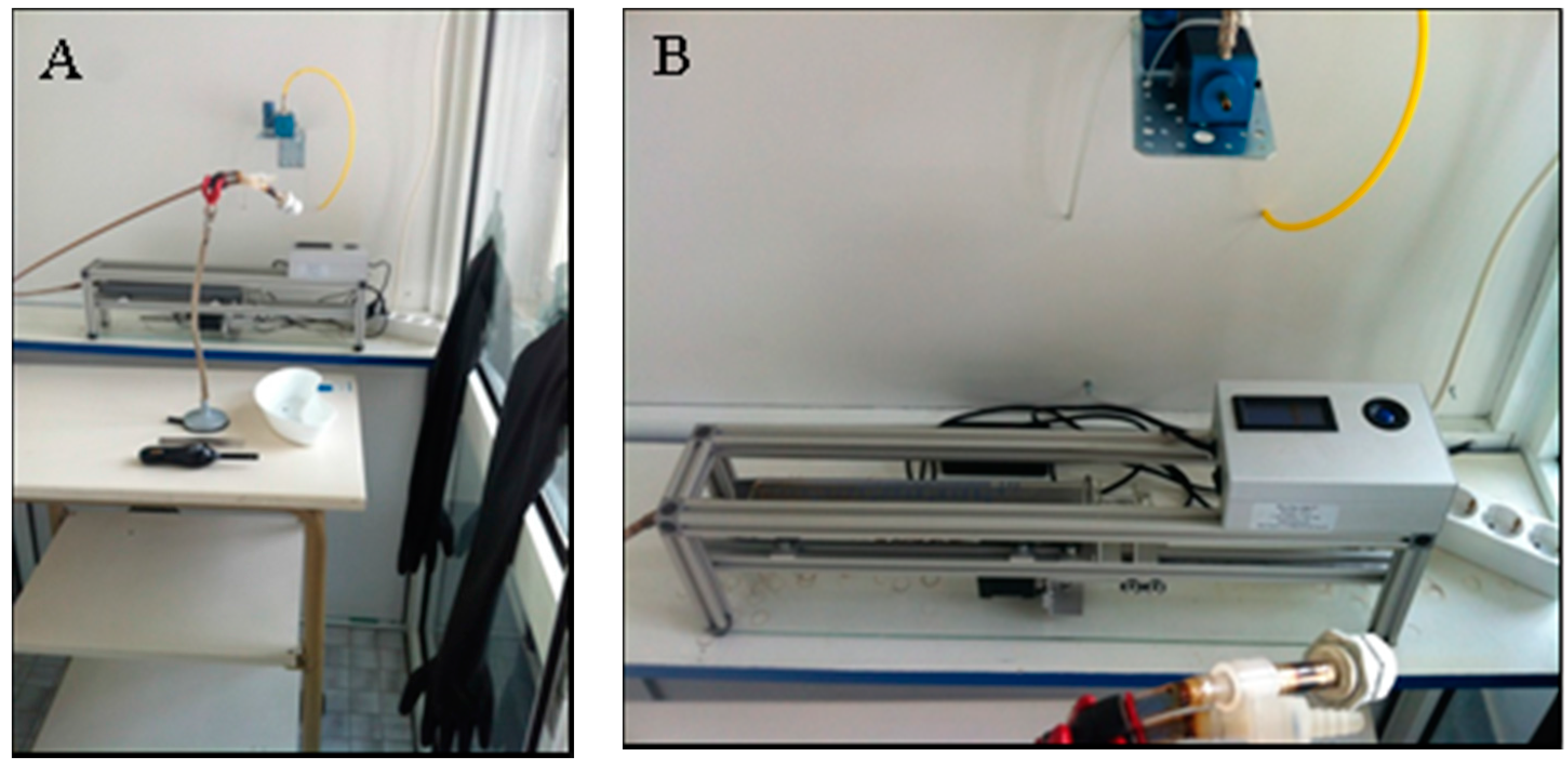


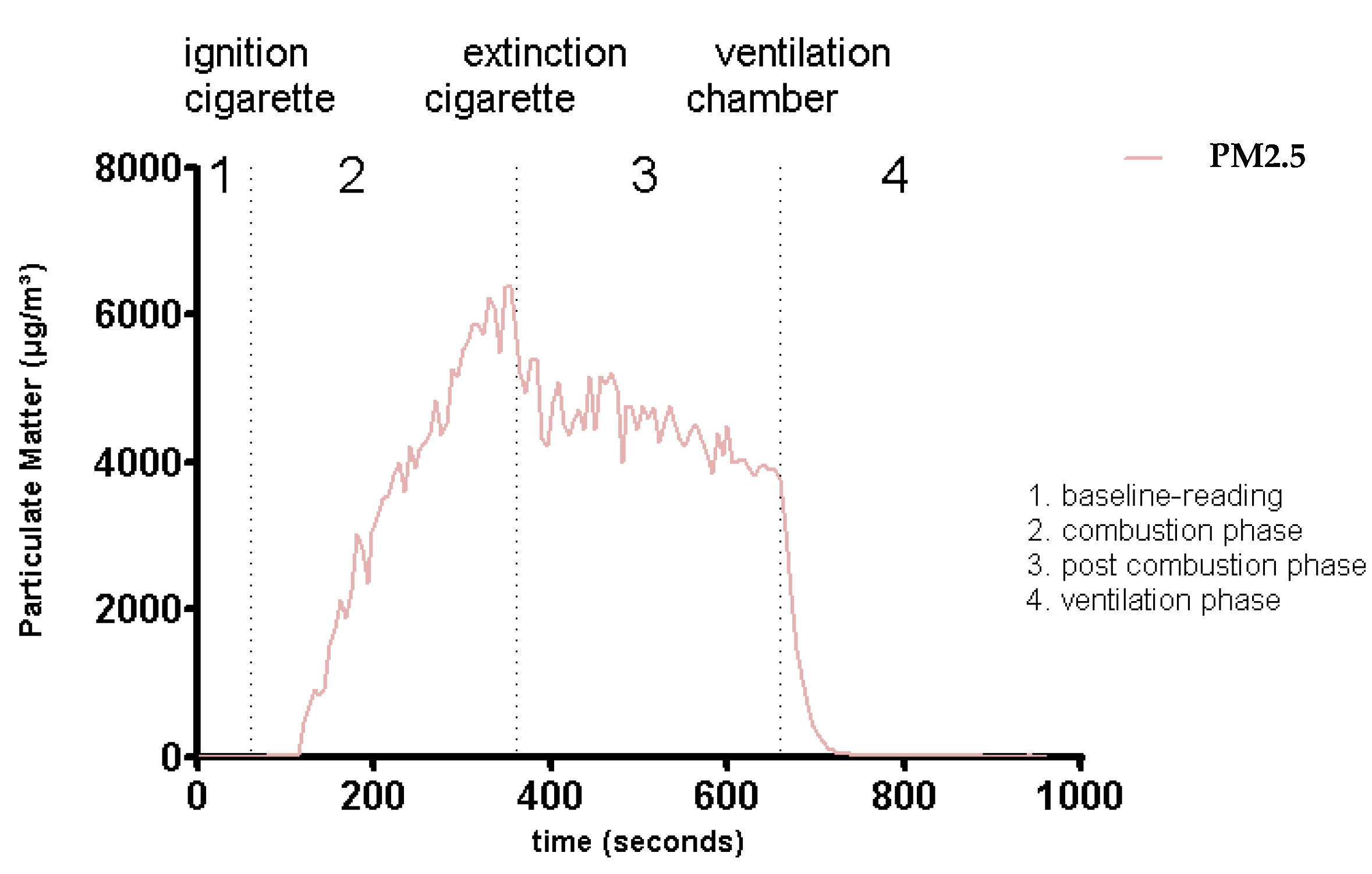
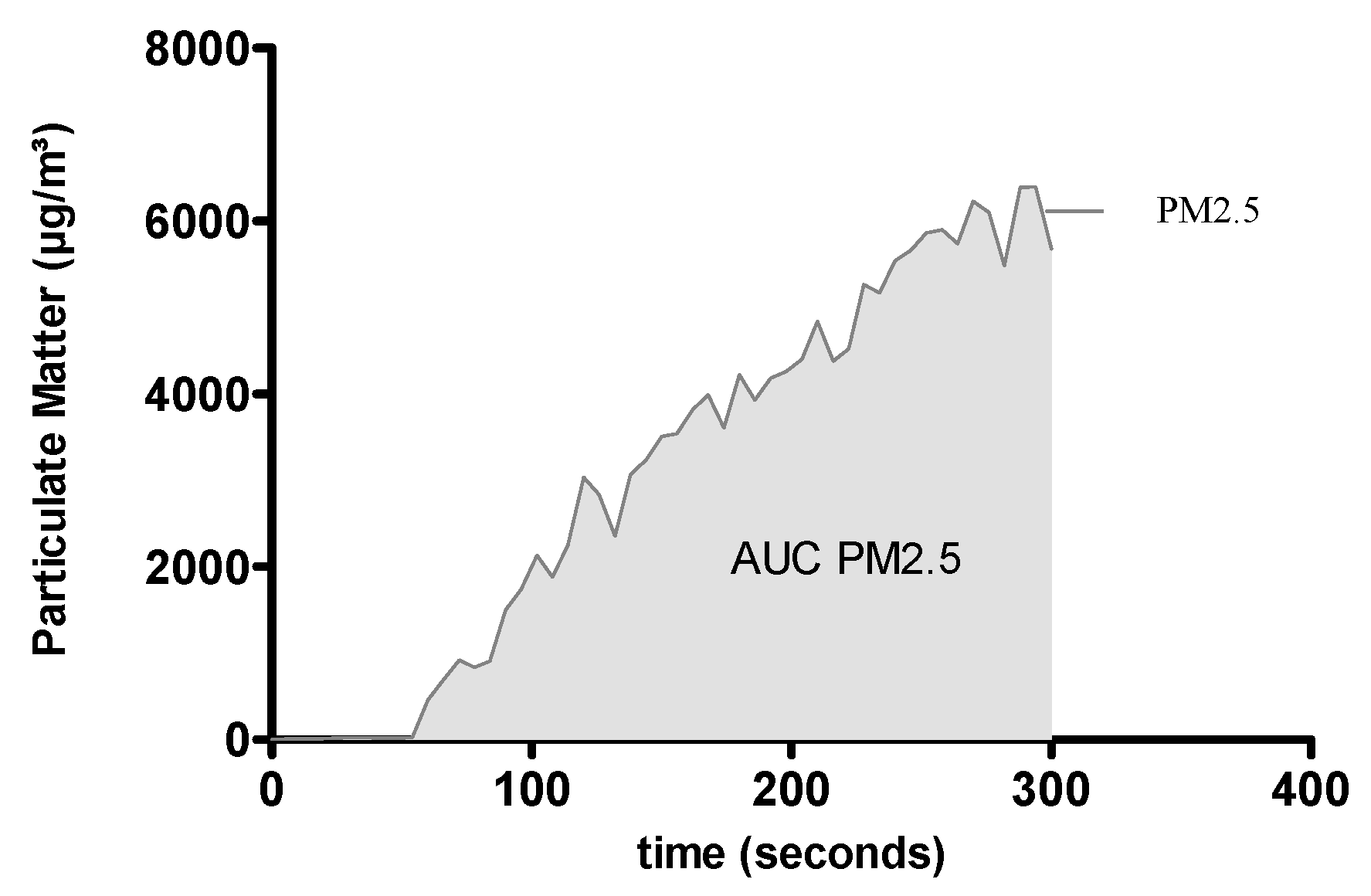
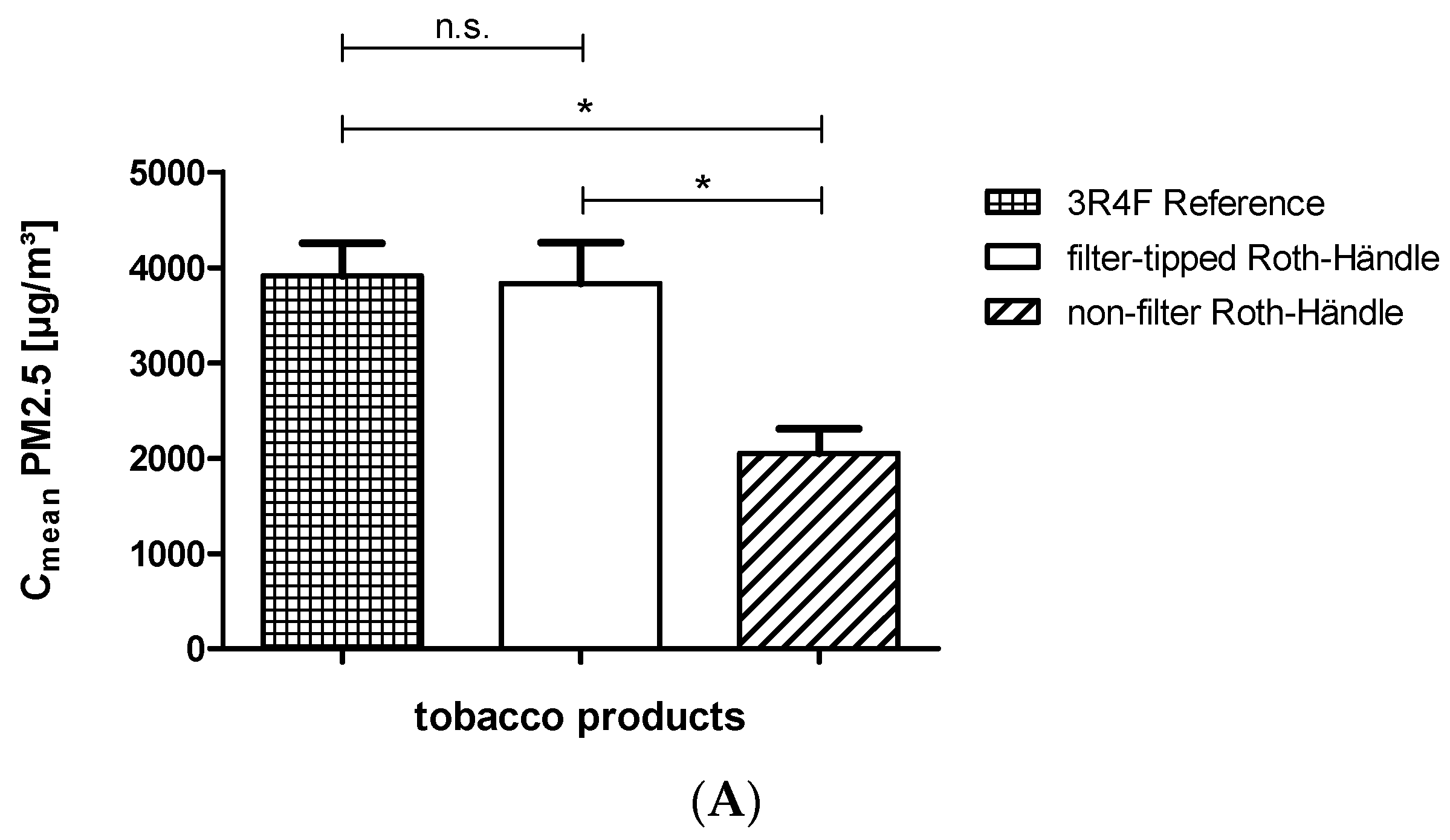
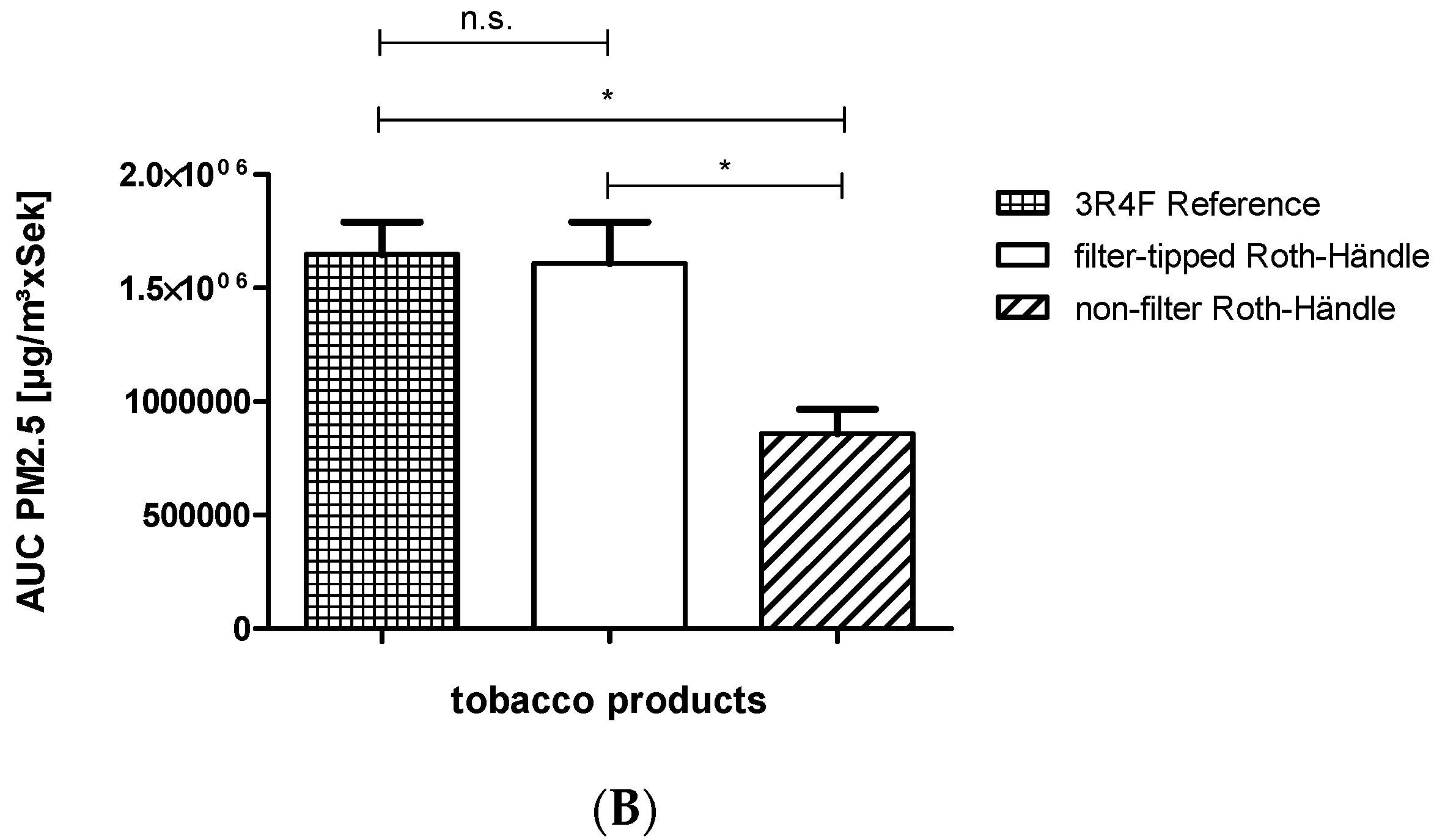
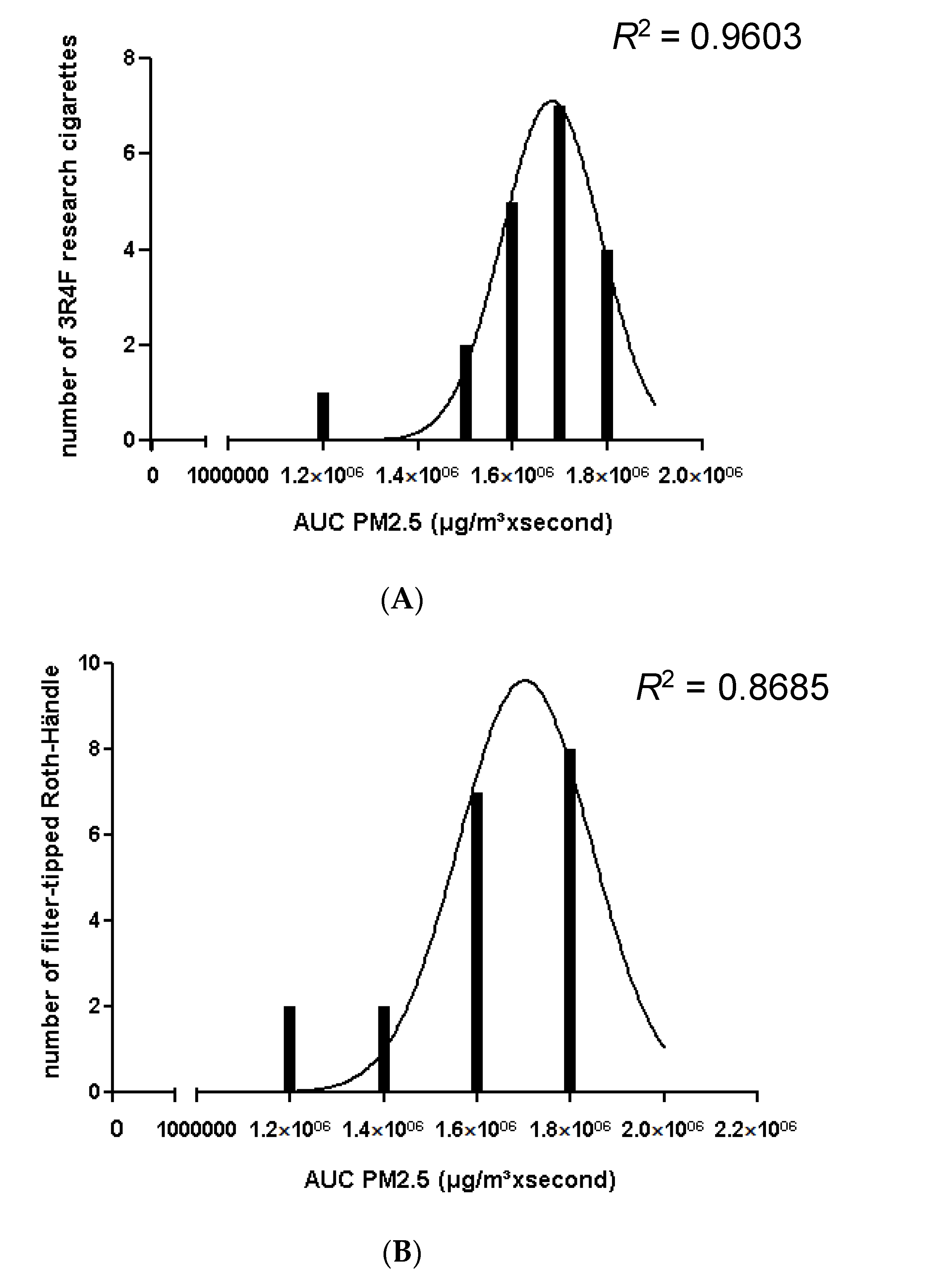

| Tobacco Products | Tar Yield Per Cigarette (mg) | Nicotine Yield Per Cigarette (mg) |
|---|---|---|
| 3R4F reference | 9.5 | 0.73 |
| Filter-tipped Roth-Händle | 10 | 0.7 |
| Non-filter Roth-Händle | 10 | 1.0 |
| Tobacco Products | CmeanPM2.5 (μg/m3) | AUC PM2.5 (μg/m3·s) | Combustion Time (s) |
|---|---|---|---|
| 3R4F reference | 3911 ± 341.1 | 1,647,006 ± 144,273 | 300 |
| Filter-tipped Roth-Händle | 3831 ± 429.2 | 1,608,000 ± 181,736 | 300 |
| Non-filter Roth-Händle | 2053 ± 254.7 | 858,891 ± 107,655 | 300 |
© 2016 by the authors; licensee MDPI, Basel, Switzerland. This article is an open access article distributed under the terms and conditions of the Creative Commons Attribution (CC-BY) license (http://creativecommons.org/licenses/by/4.0/).
Share and Cite
Schulz, M.; Gerber, A.; Groneberg, D.A. Are Filter-Tipped Cigarettes Still Less Harmful than Non-Filter Cigarettes?—A Laser Spectrometric Particulate Matter Analysis from the Non-Smokers Point of View. Int. J. Environ. Res. Public Health 2016, 13, 429. https://doi.org/10.3390/ijerph13040429
Schulz M, Gerber A, Groneberg DA. Are Filter-Tipped Cigarettes Still Less Harmful than Non-Filter Cigarettes?—A Laser Spectrometric Particulate Matter Analysis from the Non-Smokers Point of View. International Journal of Environmental Research and Public Health. 2016; 13(4):429. https://doi.org/10.3390/ijerph13040429
Chicago/Turabian StyleSchulz, Maria, Alexander Gerber, and David A. Groneberg. 2016. "Are Filter-Tipped Cigarettes Still Less Harmful than Non-Filter Cigarettes?—A Laser Spectrometric Particulate Matter Analysis from the Non-Smokers Point of View" International Journal of Environmental Research and Public Health 13, no. 4: 429. https://doi.org/10.3390/ijerph13040429





